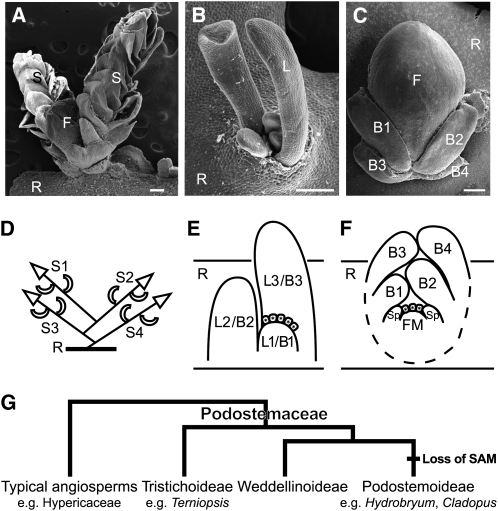Figure 1.
Morphology, Development, and Phylogeny of Podostemaceae.
(A) to (C) Scanning electron microscopy images of T. minor (A), C. doianus (B), and H. japonicum (C). Bars = 200 μm.
(A) Shoots arising on the flank of a subcylindrical root of T. minor. A shoot complex consists of two determinate shoots (S) with scaly leaves and a floral bud (F).
(B) Vegetative shoot comprising a tuft of filliform leaves (L) arising from a root in C. doianus. Note that H. japonicum has a similar vegetative shoot (see Supplemental Figure 1 online).
(C) Reproductive shoot arising from the dorsal surface of a crustose root of H. japonicum. A floral bud forms between distichously arranged bracts and is enclosed by a spathella.
(D) to (F) Schematic illustrations showing the shoot development of Tristichoideae and Podostemoideae.
(D) Sympodial shoot branching of the Terniopsis shoot complex. Each determinate shoot arises at the base of an immediately older shoot.
(E) Longitudinal section of a vegetative shoot of Cladopus. A new leaf (L1) arises endogenously at the base of an existing leaf primordium (L3), involving detachment of vacuolated cells (boxes with asterisks). Note that H. japonicum has the same manner of leaf and bract development.
(F) Longitudinal section of a reproductive shoot of H. japonicum. A floral meristem (FM) arises between and under two youngest bracts (B1 and B2), involving vacuolated cell detachment (boxes with asterisks), and forms a spathella (Sp) on the flank. Tepals, stamens, and a pistil will arise later.
(G) Phylogenetic relationship of the subfamilies of Podostemaceae (Kita and Kato, 2001). The typical SAM disappeared in the early evolution of Podostemoideae.
B1 to B4, youngest to oldest bracts; F, floral bud; FM, floral meristem; L1 to L4, youngest to oldest leaves; R, root; S1 to S4, youngest to oldest shoots; Sp, spathella.

